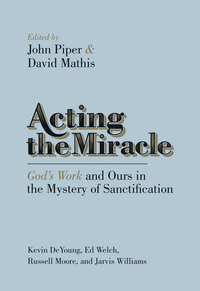Reviewed by Patrick Schreiner
Summary
Acting the Miracle had its start in the Desiring God 2012 National Conference. John Piper and company present five different chapters on the reformed view of sanctification. Mathis asserts the book is about what theologians call progressive sanctification rather than definitive sanctification. He warns against slogans or simplistic understandings of sanctification saying that the Scriptures present a more complex view of this doctrine.
Piper then defines sanctification as the action by which we bring our feelings and thoughts and acts into conformity to the infinite and all-satisfying worth of God. Romans 8:28-30 is the lens through which the place of sanctification in the salvation process is viewed.
Kevin DeYoung looks at the multiplicity of motivations in sanctification arguing there is not a solitary prescription in Scripture, but that the motivations are wide ranging. Christians are to be holy as their duty, because they are thankful, because they are justified, because of fear, because of who they are in Christ, and because of what they will be in Christ. He closes by saying that God counsels us in hundreds of ways and that pastors need to be ready to do the same and read each situation wisely.
Ed Welch examines physical disabilities and how other limitations affect sanctification giving the most pastoral and practical chapter of them all. He calls readers to remember that they are embodied souls and that they experience trouble and hardship. He then gives a range of situational counseling examples including issues such as hyperactive disorder, depression, and panic attacks.
Jarvis Williams presents maybe the most exegetical chapter looking at the personal means of grace in sanctification. But first he examines the foundation under sanctification which is God’s great work in Christ. He then highlights Scripture reading, prayer, preaching to yourself, and suffering as the means of grace for sanctification.
Russell Moore deals with the corporate dynamics of sanctification. He brings all his witticisms to bear on how the church together is meant to fight for sanctification. Piper brings it all together in the last chapter highlighting how God works in and through us to bring about holiness, but that Christians are also workers in this process.
Interaction
The strength of the book is the repeated emphasis that sanctification is not monolithic. There is not merely one motivation, it is not only an individual thing, it does not only flow from justification, it takes a range of personal means of grace, and our act in it as Edwards says is simultaneously “wholly passive and wholly active.”
Welch’s chapter in particular was helpful as he gave years of wisdom in dealing with difficult cases. His emphasis on humans being embodied souls is a needed corrective to the overemphasis on the cognitive. Readers will benefit from this chapter’s test cases which ring with wisdom and much patient thought. Pastors and counselors dealing with depression, panic attacks, and ADHD should consult this chapter especially.
Because it is a conference book, the aims of the chapters vary and there is no sustained argument. But it is still surprising that if sanctification is “conformity to the image of the Son” that none of the authors spent time on the life of the Son. In other words, where were the Gospels in all of this? Each author ran to Paul’s theological reflections, but the source of these reflections come from the life of Jesus communicated in the Gospels. This probably reflects a weakness of the broader reformed evangelical movement rather than a weakness of the book or conference.
Additionally, more meditation on the ethical implications of sanctification could have been examined. Paul’s main emphasis for the embodiment of sanctification can be encapsulated in the word “love.” And if one does not hold to a strongly reformed view of sanctification, then one will walk away from this book unsatisfied.
That said, the book does provide a helpful introduction and perspectival view of the doctrine, while also being an accessible little work.
Patrick Schreiner
Instructor of New Testament Language and Literature, Western Seminary
